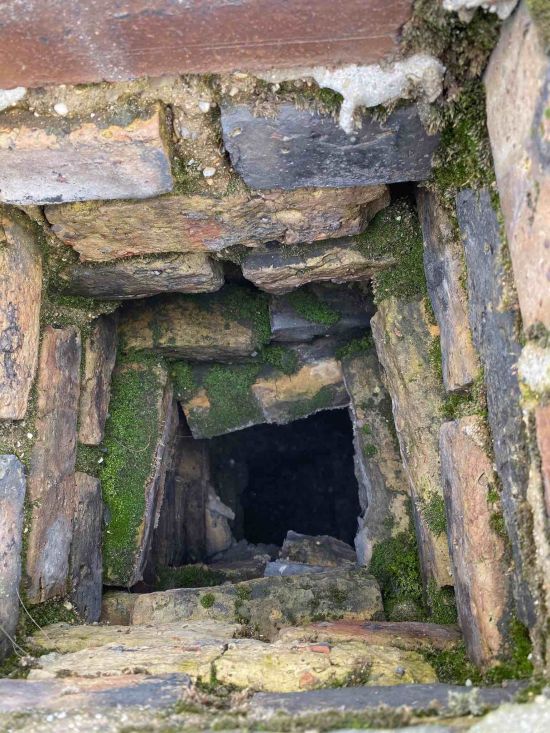Chimney Leak Survival Guide: Protecting Your Home & Hearth

Spring is here! This means we are busy helping homeowners battle Leaking Chimneys and the damage they cause. What generally starts as a minor inconvenience, if left undetected, can develop into a much larger issue, leading to costly repairs. As a homeowner, it is important to equip yourself with the knowledge to safeguard your home, and keep your chimney watertight!
At Pratt’s Chimney, we pride ourselves in our ability to inspect, diagnose, and educate homeowners whether they are dealing with a leaky chimney, or if they want to prevent future water intrusion.
Understanding Chimney Leaks & Their Causes
Understanding what is causing your chimney leak can vary, depending on the type of chimney in your home.
If your chimney chase is constructed of wood and is sided:
- Failing Flashing: Flashing creates a waterproof seal between the chimney chase and the roof. If your chimney flashing is deteriorated, pulling away from the chimney chase, damaged, or improperly installed, it can allow water intrusion into the home along the base of the chimney chase.
- Damaged Chase-Top: Chase-Tops are one of your chimney's best defenses against water intrusion, and provide the same purpose that a Chimney Crown does on a masonry chimney. These large pieces of metal are often constructed out of Galvanized metal, leaving them susceptible to rust and deterioration. At Pratt’s Chimney once we determine that your chase top is nearing the end of its lifespan we recommend that it be replaced with Stainless Steel with the proper cross bends, drip edges, and storm collar.
- Condensation: In some homes, we will notice a leak not caused by the exterior chimney, but by condensation formed within the chimney chase. The warm air from your home and fireplace, meeting the colder air within the chase, forms moisture within the chase leading to organic growth or water leaking into the home.
Masonry Chimneys tend to be a bit more susceptible to leaks for several reasons:
- Deterioration/Exposure: Masonry Chimneys in our area are exposed to freeze-thaw cycles, rain, ice, and snow Over time, all of which lead to deterioration of the chimney structure. The porous structure begins to weaken and you may discover cracks, gaps, and missing mortar joints which allow water to enter the chimney.
- Cracked Chimney Crown: The Chimney Crown is a concrete structure installed or poured at the top of your masonry chimney. Its purpose is to shed water away from the chimney flue system, while protecting the masonry structure below. When the chimney crown is damaged or deteriorated, it allows water intrusion into the interior of the chimney.
- Damaged or Separating Flashing: Flashing is the protective metal installed around the base of the chimney where it meets the roof to create a watertight seal. If the flashing pulls away from the chimney, deteriorates, or corrodes, it can allow water to enter the home around the base of the chimney.
- Settling or Shifting: As your home ages, the foundation may settle or shift, causing the original chimney alignment to be displaced. This may cause gaps, cracks, or separation between the chimney and the home. This displacement opens up weakened or exposed areas for water to enter the home.
- Lack of Maintenance: Ensuring that you maintain routine maintenance and inspection is critical in preventing and/or catching chimney leaks before they escalate into a major problem.
How Do I Know If My Chimney Is Leaking?
Often with chimney leaks, you will notice one or more signs that a leak is occurring.
- You may notice staining or discoloration on the ceiling or walls around the fireplace/chimney area.
- Musty odors in or around your fireplace/chimney.
- Dripping sounds or visible water pooling on top of your fireplace unit, around the fireplace, or appliance flue.
- Exterior signs like loose or missing brick/mortar, damaged or missing chimney caps, rust discoloration on siding, damaged or rusted siding, or efflorescence on the chimney surface
Repairing Leaking Chimneys:
Hiring a CSIA Certified Chimney Technician to inspect and determine where your leak is coming from is a great first step to selecting the proper course of action for Chimney Leak Repairs. Depending on the cause of the leak will determine the appropriate course of action for repair. If there is no direct visible cause for your chimney leak, the technician may recommend performing a Water Test to pinpoint where your leak is occurring.
The Best Prevention Is Inspection
Often chimneys show weak points for potential leak hazards well before a leak occurs. Our Certified Technicians are trained to inspect and recommend preventative measures to ensure you stay one step ahead!
Annual Fireplace and Chimney inspections are imperative to monitoring your chimney and its ability to protect against water intrusion. Leaking chimneys can compromise the integrity of your home. By understanding the common roots of chimney leaks, knowing the signs to detect them early on, and taking proactive steps to prevent future leaks, you can protect your home and ensure your chimney is operating at its’ fullest potential!

